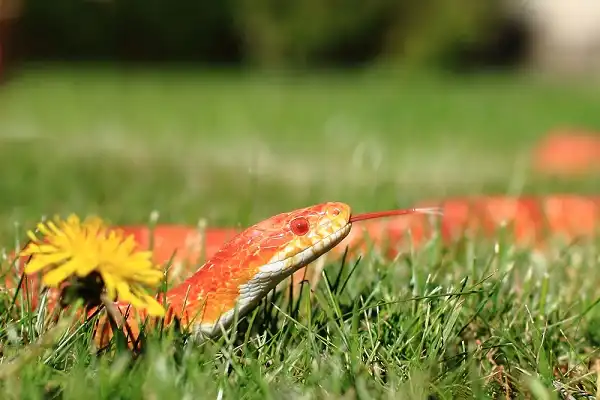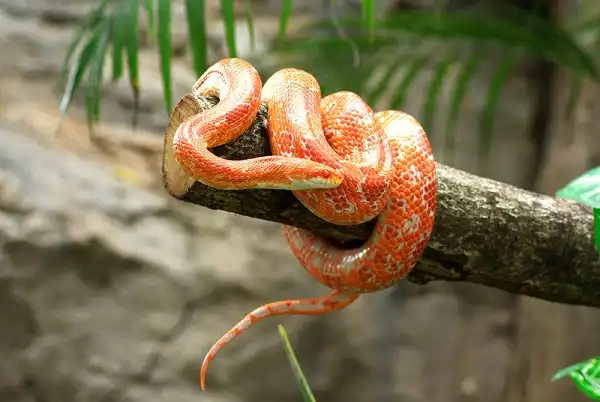Corn snakes, scientifically known as Elaphe Guttata, are recognizable reptiles that have been captivating the attention of fans across the world. With their wide variety of different colors, patterns, and personalities they can make an excellent pet choice for those looking to enter into the exciting reptile-keeping hobby! In this blog post, we will be exploring the unique characteristics of corn snakes, from their anatomy and care requirements to any fun facts you may not have heard before. For established keepers or those just starting out on this wonderful journey with these beautiful serpents – come join us for a deep dive into all things Corn Snake!

Corn Snake Description
Corn snakes are part of the Colubridae family and have a variety of colors and patterns that they can be found in. The most common colorations are red, gray, black, orange, or yellow. While not particularly large snakes this species is known for its striking colors and bold markings. The head shape is unique too; it’s somewhat triangular with more rounded edges than other snake species. The scales on a corn snake are smooth and glossy giving these reptiles an added level of beauty. They also possess two lines of stripes running from their heads down along the length of their bodies that fade out as they reach toward their tail.
Corn Snake Habitat
Corn snakes are native to the southeastern United States, but they can be found in other areas as well. They inhabit a wide range of habitats such as fields, forests, deserts, and wetlands. Generally found near sources of water like streams and rivers, corn snakes seek out places that offer plenty of hiding spots such as under logs or rocks. It is not uncommon to find these reptiles in barns and basements either; they have become quite adept at adapting to human environments. When it comes to their terrarium setup, corn snakes need an enclosure that is at least three feet long by two feet wide with a screen top for ventilation. A variety of substrate materials can be used including paper towels, aspen shavings, or coconut fiber bedding. Provide your pet with a large water bowl for soaking and misting the enclosure lightly every few days will help maintain humidity levels. Temperature-wise, corn snakes prefer slightly higher temperatures than many other species – keep your setup between 75-80°F (24-27°C) during the day and let it drop to 65-71°F (18-22°C) at night. As far as furniture goes, adding hide boxes, branches or cork bark tubes will give your snake places to rest and feel secure.
Corn Snake Diet
In the wild, corn snakes are natural predators that feed on a variety of smaller animals like mice, rats, lizards, and birds. In captivity, they should be fed small pre-killed or frozen rodents appropriate to their size. Provide your snake with one appropriately sized mouse or rat every five to seven days – hatchlings may need to be fed more often than adults due to their fast metabolism and growth rates. Once your corn snake becomes an adult it is best to stick with feeding once a week and avoid overfeeding as this can lead to health problems down the line.

Corn Snake Size
Corn snakes can range from 18-72 inches (46-183 cm) in length depending on the age, gender, and locality of the snake. Male corn snakes are generally smaller than females and usually do not exceed 48 inches (122 cm). The average adult size for a corn snake is typically around 36-48 inches (91-122 cm) long. In terms of weight, corn snakes typically weigh between 4-12 ounces (113-340 g). Younger specimens tend to be lighter while adults can reach up to 12 ounces (340 g). Hatchlings are usually only a few inches in length and weigh less than an ounce. Due to their small size and docile nature, corn snakes make great pets for those looking for something a bit different than your typical dog or cat!
Corn Snake Lifespan
The average lifespan for a corn snake in captivity is about 10-20 years with proper care. However, their longevity can depend on several factors such as the size and quality of their enclosure, diet, and level of activity. In the wild, they tend to have a shorter lifespan due to predation and other environmental factors. It is estimated that only around 20% of hatchlings make it to adulthood while many will die due to disease or being eaten by other animals. For those looking for an exotic pet to keep around for many years, corn snakes are an excellent choice! With proper care including providing a safe habitat with appropriate temperature gradients as well as an adequate food supply, these reptiles can provide hours of entertainment for many years. Overall, corn snakes are great pets for those looking for something a bit different from the norm. They require minimal care and offer plenty of interesting behaviors that can be enjoyed by both experienced and novice keepers alike! With their attractive coloration and relatively small size, these reptiles make for excellent additions to any home. Furthermore, their long lifespan ensures that you’ll have plenty of time to enjoy your new pet!
Corn Snake Behavior
Corn snakes are a relatively docile species of snake, making them great pets for those who may not have experience with more aggressive reptiles. They prefer to keep to themselves and rarely act aggressively unless threatened or handled excessively. They are also quite shy and will often hide when disturbed or startled. In terms of behavior, corn snakes like to explore their environment and hunt for food in a variety of ways such as following scent trails, burrowing into leaf litter, or crawling along open branches. However, they can also be very inactive when temperatures are too cold or warm; this is why it’s important to provide the right temperature range within their enclosure. Corn snakes are typically nocturnal which means they sleep during the day and become active at night. During this time they will use their scent organs to locate prey and then wrap around it before striking with their sharp teeth. These snakes are known for being quite vocal and can make various hissing noises when disturbed or agitated. This helps them to deter potential predators from attacking them as well as alert other animals in the area that danger is present.

Corn Snake Speed
Corn snakes are relatively slow-moving and sluggish when compared to other species of snake. They can reach speeds of up to 2 mph (3.2 km/h) when moving in the open, but this is usually only achieved for short bursts of time before they slow down again. In general, their speed is determined by the terrain and obstacles they may encounter; in areas with lots of ground cover or debris, they tend to move much slower than on a flat surface. When hunting or chasing prey, however, corn snakes are capable of short bursts of speed that can reach up to 5 mph (8 km/h). This allows them to keep up with some of their more agile predators like birds or lizards that may try to escape. In addition, corn snakes employ other methods for quickly escaping predators such as burrowing into leaf litter or taking refuge in tree hollows. These techniques allow them to quickly hide from potential threats while still keeping an eye out for potential food sources.
Corn Snake Hunting
Corn snakes are adept hunters and employ a variety of methods to capture their prey. They will typically rely on their sense of smell to locate food and then use their powerful muscles to coil around their target in order to constrict it. Alternatively, they may also stalk their prey by slowly slithering toward it before striking quickly with their sharp teeth. When hunting, the snake will usually flicker its tongue rapidly in order to detect any potential prey nearby. Its forked tongue is able to pick up pheromones and other scents that indicate the presence of food, allowing it to confidently approach its target. Once within striking distance, the snake will then either lunge forward with its mouth open or wrap itself around the prey before delivering a lethal bite. Overall, corn snakes are highly effective hunters due to their keen senses and powerful muscles. With proper care and a balanced diet, these impressive reptiles can bring years of enjoyment as well as an interesting insight into the fascinating world of reptile behavior!

Conclusion
Corn snakes make excellent pets for those looking for something different than the traditional dog or cat. They are relatively slow-moving and docile, yet still, possess enough speed and agility to catch smaller prey such as mice and lizards. With their keen senses, they can employ a variety of methods in order to locate and capture food while using their instinctive defense mechanisms to deter potential predators. Overall, corn snakes require an appropriate habitat with plenty of hiding spots as well as a balanced diet in order to stay healthy and active. However, with proper care, these reptiles can provide years of enjoyment along with an interesting insight into the fascinating world of reptile behavior!
Frequently Asked Question


